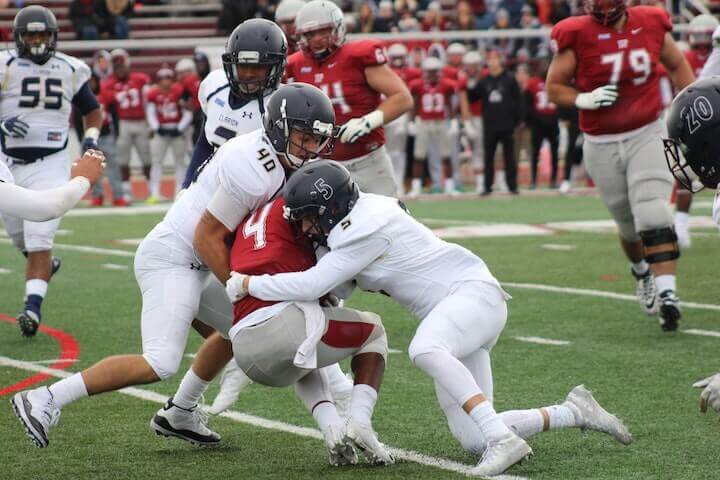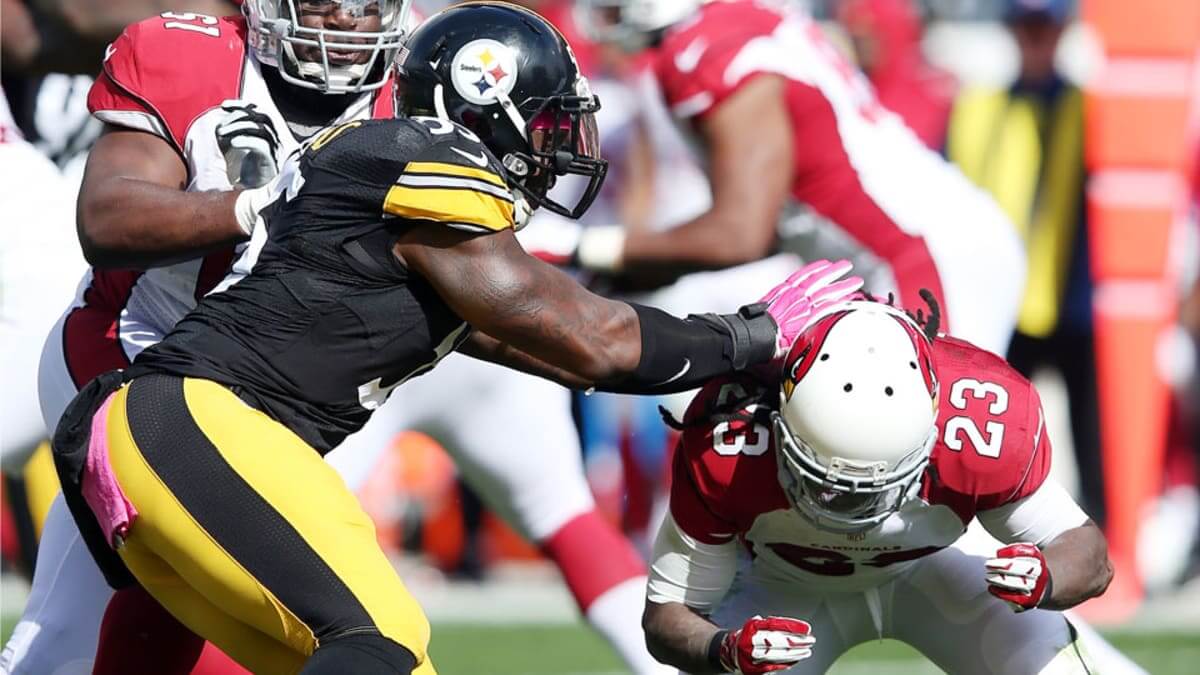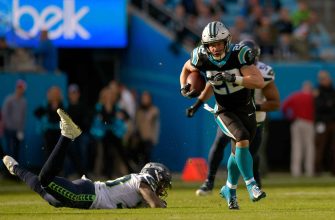A chip block in football is a type of blocking technique used by offensive players. It involves an offensive player briefly engaging with a defensive player before releasing to run a pass route or hand off the ball. The purpose is to momentarily obstruct the defender, preventing them from disrupting the play.
A chip block is executed by an eligible receiver like a tight end or running back. It is a quick block, just long enough to impede the defender before disengaging. The blocker aims to “chip” the defender, slowing their rush before proceeding with their assignment on the play. Proper timing and accuracy are critical for an effective chip block in football.
Purpose of a Chip Block
The main purpose of a chip block in football is to help block pass rushers and protect the quarterback. As the name suggests, it involves a “chip” or quick block by a running back or tight end against an oncoming pass rusher. By chipping the rusher, it slows them down just enough to allow the offensive tackle to get in position to pick them up.
This helps buy the quarterback extra time in the pocket to find an open receiver downfield. Without the chip block, a free rusher could get a clear path and sack the quarterback. So the chip block is an important technique to disrupt the pass rush and prevent negative plays. The goal is to obstruct and redirect the rusher just long enough for the offensive tackle to engage. When executed properly, it helps neutralize the pass rush and protects the quarterback.
When Chip Blocks are Used

Chip blocks are most commonly used on passing plays to give the quarterback extra time to throw the ball downfield. The chip blocker will briefly engage with a pass rusher like a defensive end or outside linebacker before releasing into their route. This helps slow down the initial rush just enough to allow the offensive tackles to secure their blocks.
Chip blocks are especially useful on third downs when the defense is likely to blitz and bring maximum pressure. By chipping a blitzer, the blocker can disrupt the timing of the blitz and prevent a more dangerous free rusher. The chip gives the offensive line those extra split seconds to pick up their assignments.
Chip blocks also help counter edge rushers that have a favorable matchup against the tackle. Having a running back or tight end chip the rusher on their way out can offset any physical mismatch. This assistance keeps the quarterback cleaner and buys more time to scan for open receivers.
Who Performs the Chip Block
The chip block is most often performed by running backs and tight ends. These positions are ideal for executing a chip block because they often line up near the outside of the offensive line, which puts them in position to help block blitzing defenders on the edges.
Running backs will sometimes motion across the formation prior to the snap specifically to get in position for a chip block. This allows them to help shore up protection against a dangerous pass rusher while still being available as a receiving option.
Tight ends also frequently chip block, especially on obvious passing downs. They can engage the defensive end or outside linebacker for a moment to disrupt their pass rush before releasing into a route. Their dual blocking and receiving abilities make tight ends well suited for chip blocks.
Executing effective chip blocks requires running backs and tight ends to quickly diagnose blitzes and make the correct pre-snap adjustments. Their timing and technique are crucial to momentarily obstructing the defender’s path to the quarterback. When done properly, chip blocks buy the offensive line valuable extra time to sustain their pass protection.
Technique for an Effective Chip Block

To execute an effective chip block, the running back or tight end must use proper technique. They must stay low to gain leverage on the pass rusher and deliver a solid blow with their inside shoulder directly into the defender’s midsection. The blocker wants to make direct contact with the defender to momentarily knock them off balance before releasing into their route.
It’s crucial for the blocker to stay low, keep their feet moving, explode into the contact, and strike the defender squarely with their shoulder. A chip block executed properly can effectively slow down a pass rusher and disrupt their path to the quarterback.
Importance of Timing and Accuracy
Proper timing is crucial for an effective chip block in football. The blocker must connect with the pass rusher just as the rusher approaches the quarterback or running back. If the timing is off by even a fraction of a second, the chip block will fail to slow the pass rush.
Additionally, the blocker must have pinpoint accuracy when chipping the rusher. A missed chip block can allow the rusher to blow past untouched. The blocker aims to make solid contact on the rusher’s shoulder or midsection to momentarily disrupt their momentum. Proper timing and accuracy are what make chip blocks effective in neutralizing a dangerous pass rusher. A failed chip block can result in a sack or quarterback pressure.
Advantages of the Chip Block
The main advantage of using a chip block is that it slows down the pass rush and buys the quarterback more time to throw the ball. By having a running back or tight end briefly engage with a blitzing defensive end or linebacker, it disrupts their path to the quarterback. This extra second or two is often the difference between a clean pocket and a sack.
The chip block does not need to completely block the rusher, just redirect them slightly off course. This allows the offensive tackle to properly set up and prevent the rusher from blowing by into the backfield. Overall, the chip block is an effective way to counter aggressive pass rushing defenses without having to keep extra blockers in the backfield. The offense maintains balance while still giving the quarterback room to operate.
Disadvantages of the Chip Block
The main disadvantage of using a chip block is that it can take a receiving option out of the play. When a running back or tight end is assigned to chip block, it delays the timing of their route. This usually eliminates them as an initial receiving target for the quarterback on that play.
The chip blocker must engage the rusher and then release into their route, which disrupts the timing with the quarterback. Using a skill position player solely as a chip blocker sacrifices a potential receiving threat in order to provide pass protection.
Famous Examples

One of the most famous chip blocks in NFL history was executed by Dallas Cowboys running back Emmitt Smith in Super Bowl XXVIII against the Buffalo Bills in 1993. Smith chipped Buffalo defensive end Bruce Smith just enough to slow down his pass rush and allow quarterback Troy Aikman time to complete a touchdown pass. Emmitt Smith’s perfectly timed chip block neutralized one of the best pass rushers in NFL history just long enough for the play to develop.
This play demonstrated how a running back’s chip block on an elite defensive lineman can make the difference between a sack and a touchdown. Emmitt Smith showcased excellent technique, timing and execution on the chip block despite being much smaller than Bruce Smith. The chip block enabled the Cowboys to beat the Bills for their second straight Super Bowl title.
Conclusion
The chip block is an important blocking technique in football, especially when facing elite pass rushers. It involves a running back, tight end, or other player briefly blocking a defensive end or linebacker before going out for a pass route. The key goals of a chip block are to disrupt the defender’s rush and buy the quarterback extra time in the pocket.
When timed well, chip blocks can momentarily stagger dangerous pass rushers and prevent them from getting to the quarterback quickly. This gives the QB a split second longer to scan the field and find an open receiver. While chip blocks don’t completely neutralize pass rushers, they are an effective way to slow them down.
Overall, the chip block requires precision, timing, and teamwork to execute properly. When used strategically, it gives offenses a schematic advantage against aggressive defenses. Mastering the chip block technique allows teams to keep pass rushers guessing and better protect the quarterback. It remains an integral part of offensive gameplans at all levels of football.








